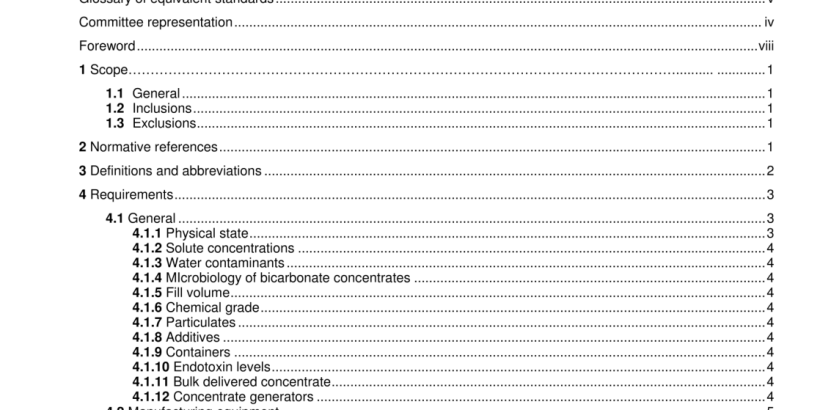ANSI AAMI RD61-2006 pdf download
ANSI AAMI RD61-2006 pdf download.Concentrates for hemodialysis
1.1 General
For the purpose of this standard, “concentrates” are a mixture of chemicals and water, or a mixture of chemicals in the form of dry powder, that are delivered to the end user to make dialysate used to perform hemodialysis. This standard is addressed to the manufacturer of such concentrates. In several instances in this standard, it became necessary to address the dialysate, which is made by the end user, to help clarify the requirements for manufacturing concentrates. Because the manufacturer of the concentrate does not have control over the final dialysate, any reference to dialysate is for clarification and is not a requirement on the manufacturer. The requirements and goals established by this standard will help ensure the effective, safe performance of hemodialysis concentrates and related materials.
1.2 Inclusions
This standard includes bicarbonate and acid concentrates in both liquid and powder forms. Also included are additives commonly called“spikes,” chemicals which may be added to the concentrate to increase the concentration of one or more of the existing ions in the concentrate and thus in the final dialysate. This standard also gives requirements for equipment used to mix acid and bicarbonate powders into concentrate at the user’s facility.
1.3 Exclusions
Although references to dialysate appear herein, this standard does not address dialysate. Also excluded from the scope of this standard are requirements for monitoring the purity of water used for mixing concentrate at a dialysis faciity. The recommendations of this committee for monitoring water quality are contained in ANSI/AAMI RD52:2004, Dialysate for hemodialysis. Also, this standard does not address bags of sterile dialysate.
3.6 bicarbonate concentrate- dry: Dry bicarbonate that may contain sodium chloride that is provided to a user in the appropriate proportions, that when mixed with a specific quantity of treated water will create a liquid concentrate that can be used in conjunction with acid concentrate and treated water to make dialysate in a dialysis machine. Dry bicarbonate may also be used in a concentrate generator to produce a saturated solution of sodium bicarbonate used by the dialysis machine to make dialysate. NOTE- -In some machines dry powder is used to produce a batch of final dialysate.
3.7 bulk delivery: The delivery of large volumes of concentrate in which the product is transferred (pumped) from the delivery container to a user s storage tank. NOTE- Bulk delivery includes containers such as 55 gallon drums, which may be pumped into a storage tank maintained at the user’s facility. Alternatively, the drums may be left at the facility and used to fill transfer containers to transfer the concentrate to the machine.
3.8 concentrate generators: A system where the concentrate is delivered to the consumer as a powder in a container, suitable to attach to the dialysis machine it is intended to be used with and then converted into a concentrated solution by the dialysate supply system. This solution is used by the dialysate supply system to make the final dialysate delivered to the dialyzer.
3.9 dialysate: An aqueous fluid containing electrolytes, buffer, and, usually, dextrose that is intended to exchange solutes with blood during hemodialysis. The word “dialysate” is used throughout this document to mean the fluid made from treated water and concentrate or concentrates, as appropriate, that is delivered to the dialyzer by the dialysate supply system. Phrases such as“dialyzing fluid” or“dialysis solution” may be used in place of dialysate. It does not include peritoneal dialysis fluid.
